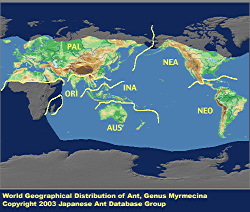
|
genus
|
Myrmecina
|
 |
Japanese Name
|
Kadofushi-ari-zoku
|
Original Reference
|
|
Curtis, J. (1829) British Entomology; being illustrations and descriptions of the genera of insects found in Great Britain and Ireland 6: 242-288. London.
|
Description
|
|
Total length of workers around 2 - 5 mm. Antennae 12-segmented; the apical 3 segments forming a club. Occipital collar developed, running ventrally almost to the mandibular insertions. Clypeus raised medially; anterior margin projecting forwards. Mandibles robust, framing a space, when closed, between their basal margins and the anterior border of the clypeus. Mesosoma depressed dorsally; mesopleuron laterally expanded, partly covering the fore coxae. Metanotal groove indistinct. A small paired process present anterior to the base of each propodeal spine. The latter distinct. Petiole sessile, without peduncle.
|
|

|
Remarks
|
|
Myrmecina comprises about 20 described species, distributed in tropical and temperate areas of the Palaearctic, Oriental and Australian regions, with many apparently undescribed species in SE Asia and New Guinea. Found on the forest floor, nesting in soil. Masuko (1983) suggested that these ants are specialist predators of oribatid mites. Myrmecological Society of Japan Editorial Committee (1988) nominated 2 species, and remarked on the presence of 3 or 4 more in Japan. Although the taxonomy of the Japanese species is incomplete, 4 species are treated here. Further examination of material from the Sakisima Islands of the Nansei group is required.
|
References
|
|
- Masuko, K. (1983). Some behavioral observations in Japanese ants. . Ari, (11), 1-2. .
- Myrmecological Society of Japan, Editorial Committee (ed.) (Ed.). (1988). A list of the ants of Japan with common Japanese names. The Myrmecological Society of Japan, Tokyo.
|
Editor
|
|
Original text by Kazuo Ogata and Mamoru Terayama. English translation by Kazuo Ogata, edited by Robert W. Taylor.
|
|